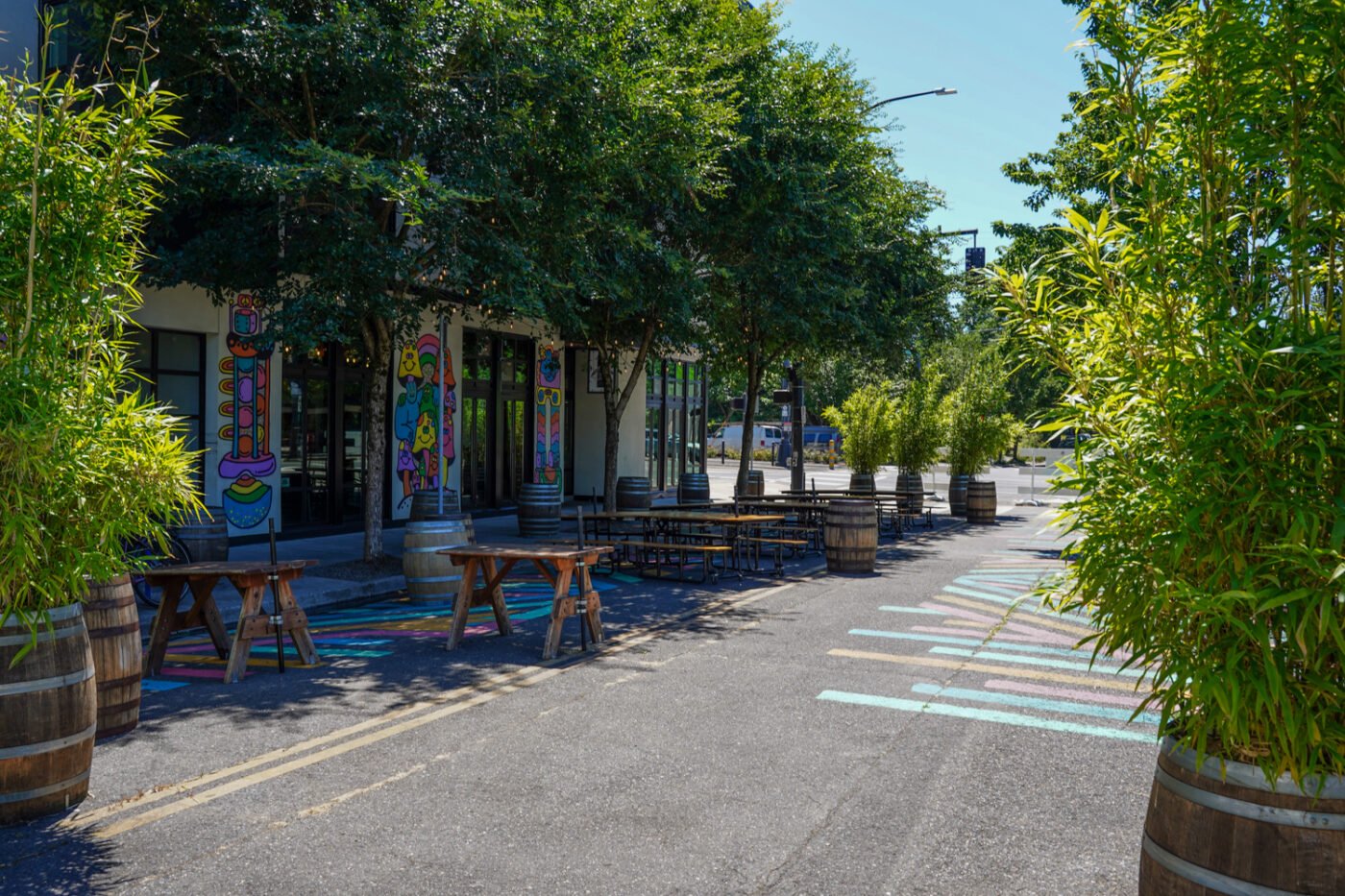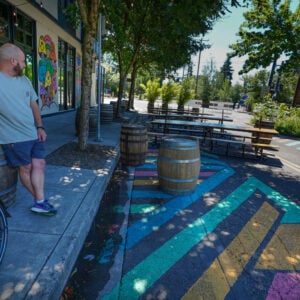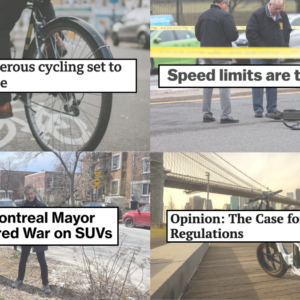Last week we shared a story about how the owner of Mayfly Taproom in Kenton was alarmed because the Portland Bureau of Transportation (PBOT) wanted to re-open the plaza in front of his business to car drivers. PBOT has said Fenwick Plaza doesn’t fit their vision for a neighborhood public street space and would have to be removed this fall. But now the city might reconsider that position based on community feedback and the issue has sparked a robust conversation about public plazas and who they serve.
For the past three years, Mayfly owner and proprietor Ryan Born has relied on a carfree block on N Fenwick Ave (at N Interstate) to, literally and figuratively, expand his business. Born credits the colorful tables and space in Fenwick Plaza as the reason he’s survived the rocky post-pandemic years. He feels if PBOT allows drivers to use the street again it will hurt his business, be a loss for the community, and make the street more dangerous.
“It raises questions as to whether this location is where Kenton neighborhood wants us to invest limited placemaking resources.”
– Dylan Rivera, PBOT
Born operates his plaza under the same Healthy Business Program permit he received when the program first launched in fall 2021. That program ended in August 2023 (because the federal funding that paid for it ran out) and morphed into what’s now called the Outdoor Dining Program. Unlike the Covid era Healthy Business Program, the new Outdoor Dining program (which was formally adopted by city council in August 2023) offers permits for sidewalk cafes and street seats — but does not include carfree street plazas.
Turning former streets into public spaces requires more planning than simply using the sidewalk or a few parking spaces, and PBOT hasn’t completed all the necessary budgeting and policy work to make them a permanent part of their portfolio. Amid staff turnover and a recent budget crisis, PBOT’s Public Street Plaza Program remains in pilot mode and has made slow but steady progress since its launch at an enthusiastic press conference in March 2022. The city continues to work on things like plaza design standards, maintenance agreements, activation methods and so on.
Part of the issue with Fenwick Plaza (and a few other plazas whose locations I’m still trying to track down) is that it’s caught in a bureaucratic grey area. These spaces exist around town, but they’re operating without a solid policy foundation and the plan for their future remains unclear.
Another issue at play is who benefits most from these spaces. During the creation of their Outdoor Dining program PBOT heard concerns from some Portlanders about the “over privatization of the right-of-way,” said PBOT spokesperson Dylan Rivera in an email to BikePortland Friday evening. Put another way, PBOT wants to make sure these plazas — which are on streets in the public right-of-way — primarily serve the public, not a single private business.
On Friday I asked PBOT: Is the crux of the issue with Fenwick Plaza that PBOT believes it only serves one business?
“Yes,” Rivera replied. “In the sense that it raises questions as to whether this location is where Kenton neighborhood wants us to invest limited placemaking resources. We would love to be able to create multiple public plazas in every neighborhood but, at this moment, in our program infancy, we are unable to spread ourselves so thin.”
To make a plaza successful, PBOT says they require materials like planters, picnic tables and other types of seating, even public art. And staff and funding are needed to deal with things like graffiti, garbage, and replacing broken traffic control devices and other damaged furnishings. PBOT has also paid for live music performances in some plazas. “It’s a considerable investment,” Rivera says.
Rivera also said selection of plaza locations, “Is not as simple as evaluating whether a location checks all the boxes on a list of criteria.” PBOT wants to make sure a plaza will be maintained and activated. “Plazas require partnership between the city on the one hand, and businesses and community organizations on the other. It should be a process of working with the community to determine where a plaza could provide the most public benefit, and then working with that community partner on how to best design and activate that space.”
“Sort of like how PBOT works with communities to identify the best route for a neighborhood greenway or other transportation investment,” Rivera added.
When it comes to Fenwick Plaza specifically, Rivera said, “Earlier this month we gave [Ryan Born] and his business partners a heads up that with the formalization of the public street plaza we might not be able to justify a public street plaza at this location.” PBOT has proposed making Fenwick one-way northbound for road users and giving Born a permit for outdoor dining in the other lane.
As word has gotten out, PBOT has heard considerable support for Fenwick Plaza from the Kenton community. Based on that, it now appears PBOT might reconsider their previous decision.
A reader forwarded an email to BikePortland from the PBOT staffer in charge of the plaza program. On Friday afternoon, the PBOT staffer wrote: “Maintaining Fenwick as a public street plaza remains an option if the community choses it as the place where the greatest public space value can be attained.”
At the Kenton Neighborhood Association’s August 14th meeting (7:00 pm at Kenton Firehouse), PBOT will propose an alternate location that is closer to the Denver Avenue commercial corridor — specifically N McClellan on the west side of Denver. “This location is shaded, in the heart of pedestrian activity, has a lot of active land uses next to it, hosts the farmers market, and offers an opportunity to create a larger public plaza space,” wrote the PBOT staffer in an email, who also said they’re interested in hearing other location ideas.
These street plazas emerged from the chaos of Covid and have become one of the most popular PBOT endeavors in years. But as we’ve seen with programs like Sunday Parkways, popularity doesn’t always lead to pervasiveness.
Stay tuned for updates. Consider attending the meeting on August 14th and make sure you take PBOT’s current street plaza survey.
UPDATE, 7/23 at 5:50 pm:
Below is a Q & A based on emails between BikePortland and PBOT spokesperson Dylan Rivera:
Can you share an estimate for annual cost to PBOT for maintenance/implementation of a Public Street Plaza?
Current costs for the city can range from $20,000 to $35,000 a year for materials and services — not including city staff time.
Also, related to the budget question: If a business owner in a situation like Ryan and Mayfly was willing to pay for the upkeep and implementation of a full street plaza, would PBOT allow that?
We offered that option during the COVID-19 pandemic but that is no longer an option the bureau offers. If we were to start offering full street plazas to individual businesses, it would likely need to be established in a citywide policy.
It would likely be incredibly difficult to apply and manage fairly in a way to benefits the whole community. Street sizes and business sizes vary so much. It would be very challenging for the city to ensure businesses are activating the plazas and maintaining them in a way that makes them an asset to the community.
Or is it more about the public right-of-way for private gain and not solely a question of who foots the bill?
Yes. The public has expressed a concern about the privatization of the public right of way. This concern led to policy being developed that does not provide for a single business to close an entire street for business purposes. That said, we are exploring an idea for a seasonal plaza option that would provide curb to curb space, to test locations that could be suitable for a future plaza that could be year around — or just offered seasonally. Alternatively, perhaps some plazas would be most successful if they are operated only in the summer.
(As we shared with you on Friday.) One of the concerns that we heard in developing the Outdoor Dining Program was the over privatization of the right of way. To address that concern, when PBOT formalized the Outdoor Dining Program in August 2023, we removed the option to have a private Healthy Business street closure permit for private use of a street. Mayfly is one of a few outstanding Healthy Business permits with curb-to-curb plaza spaces — which are not allowed under the Outdoor Dining Program that Council approved — that we are trying to find solutions for.
Or, is this question something that PBOT simply doesn’t have an answer for yet because the policy isn’t finalized?
Yes, we need to do more work to develop the policy.








Thanks for reading.
BikePortland has served this community with independent community journalism since 2005. We rely on subscriptions from readers like you to survive. Your financial support is vital in keeping this valuable resource alive and well.
Please subscribe today to strengthen and expand our work.
Someone should call up some places where plazas are common, probably even required, like Spain or Mexico. Ask the local government if maintaining plazas is more or less costly than maintaining roadways open to cars.
If the city and PBOT’s goal is to get to 25% of trips by bicycle and 70% of all trips to not be drive alone, (https://www.portland.gov/transportation/planning/documents/tsp-101-two-pager/download) then we need more bikeways, more plazas, and more closed roads, especially those near transit corridors.
Well, for what it’s worth, I agree that the McClellan location would be better. Sure, do that.
The problem I still have is in the false dichotomy. Do both. If the Mayfly wants to use the plaza, they can deal with graffiti and tables. All PBOT needs to do is officially close the road. Not one way, just completely. It’s an asphalt park with no amenities. The barriers are already there to block traffic, that’s not an ongoing cost, unless they’re talking about adding new concrete planters. Sure, they should do that but how much does a planter or a jersey barrier (or six) cost?
I agree. The McClellan location is much better overall. This is a tricky issue and I’m glad we’re having a debate about it. The plaza program is important and it must be a big success if we want more carfree space around town.
I also would love if PBOT would just “do both.” But I can see their perspective too. PBOT owns and manages the right-of-way. It’s public space that they cannot and should not simply give away willy-nilly. When you run a city the rules have to work citywide and be the same for everyone. What about other n’hoods where a business owner doesn’t step up like Mayfly and/or there’s not business with enough extra cash to pay for the upkeep of a plaza themselves? There are huge equity issues that PBOT thinks about on stuff like this and they don’t want to set an unfair precedent in one n’hood.
I also respect that PBOT understands successful plazas take much more work to implement than most people think. Especially in America and in a place like Portland with relatively low human density. It’s bad for our movement if plazas are established and then fail.
This reminds me of Sunday Parkways frequency debate. I want more Sunday Parkways all over the place. But PBOT won’t expand the program because they have a formula they are committed to that costs a certain amount of money and has policy backing and support from city council. If PBOT said, “OK let’s do a bunch more” and something happened or they were spread too thin or whatever, it could jeopardize the entire program.
Don’t get me wrong. I’m not making excuses for all of PBOT’s decisions, just trying to help folks understand where I think they are coming from.
PBOT needs to be held accountable and needs to be pushed to do more faster. But most of the rank-and-file want the same things we want, so just keep that in mind when you think about stuff like this. And let’s figure out a way to be strategic to get what we want (more carfree plazas! More sunday parkways). We just have to go about it in the language PBOT understands.
You obviously understand the complexity, and I would love for this perspective to be integrated into future articles. It would make them much stronger.
Yeah I hear you about that. But I feel like it can quickly get messy if I interject too much opinion and reflection about PBOT into articles like this. I tend to prefer to separate that into clearly labeled editorials but admit that you are right and my posts here would benefit from me sharing more personal insights on stuff. I have just been through the ringer so many times that it’s sort of self-preservation mechanism to not editorialize too often in posts that are news oriented like this one. It’s a tricky balance!
It’s not the opinion part I was responding to, but rather the analysis of why PBOT doesn’t just do the thing the article is essentially making a case for. You know why it’s more complicated than you often make it seem, so why not include that complexity in the article? (One possible answer: you don’t want to be falsely painted as pro-status quo as I often am.)
What often happens is you write an article that provides almost the entirety of information most people have on a topic, and people react with “why is PBOT so stupid?” and get angry with the city.
If you know what PBOT is thinking, explain it, and at least let people get past they “they’re hopeless dumbasses” to “I see their point of view, and I have an idea for how to address their concerns and still get more of what I want”. Understanding the difficulty with a problem is a much more powerful position to be in if you want to change policy.
If people are left with the impression that “it’s messy and complicated”, all the better. Because it usually is.
Can’t the city offload some of the maintenance to the adjacent property owners or businesses who stand to benefit? Plantings, cost of barriers, paint, etc come to mind. This would allow the program to expand. I would guess, but don’t know for sure, that the pavement would last longer with a plaza over it than trucks, cars, and other vehicles running over it all day.
The whole public space thing just rings so hollow when part of that usage is private vehicle storage. Once again why is that storage more important public use than storage of human bodies on tables and benches? Or safe transit for folks not in cars?
Are the costs really “considerable” or are they just non-trivial?
It would be helpful for this discussion to understand what “considerable” costs represent.
Street Plazas and making sections of the ROW car-free shouldn’t have to be zero-sum endeavor.
Street plazas and maintenance agreements should be set up for success.
I agree. I asked PBOT this morning to share an estimated annual cost and they say they’ll get back to me tomorrow.
I think “non trivial,” and “considerable,” pretty much mean the same thing to PBOT.
Non-trivial things are indeed worthy of consideration. If they weren’t, they’ve be trivial.
Are you being deliberately obtuse?
About 14 months ago, PBOT closed Oak Street between Burnside and SW 10th Ave to create Pod Plaza downtown; now it thinks that Fenwick Plaza is somehow less desirable. I wonder what else is going on internally at PBOT relative to downtown and places outside of downtown. https://bikeportland.org/2023/05/04/how-a-young-urbanist-turned-a-slip-lane-into-portlands-newest-plaza-374525
Closing Fenwick made accessing the Max station from the east side substantially safer. When that bit of Fenwick was open to driving, it provided a cheat route for drivers when they caught a westbound red light on Interstate. Timing was really tight – no time to slow down turning right. Then choose between full throttle down Fenwick, or go tearing through the Dancing Bare parking lot. Run the stop turning left onto Argyle, then assume there’s no southbound train and run a right on red onto Interstate. Plenty of room to squeeze in after the tracks and block the bike lane and crosswalk waiting to pull into the gap created by the red light they’re dodging, into the same spot they had in line when they started. I used to commute through there and that was something I remember watching out for in particular.
It’s literally a few feet of street happy to have N McClellan too. But is it too much to ask that we have more places in N Portland that are car free?
So..
It’s not just one business. There are regular food trucks, art vendors, indie brewers, etc. There’s open public seating and mayfly handles the garbage. Seems they check all the boxes.
“Doesn’t fit their vision for a neighborhood public street space?” Umm… PBOT’s vision?
Seriously. I always get shouted at for expressing the idea that those with the biggest stake should have the loudest voice, but neighborhoods should be creating the vision and deciding where to put these plazas.
PBOT’s role should be to support them and provide technical assistance.
I’m a fan of plaza streets.
After visiting Europe for the first time in 2015 I realized that *every* city and town in Europe has plaza streets. Most cities have car-free plazas at the center. They’re big, magical and quiet. Astonishingly quiet to me as an American.
Plaza streets are a big step forward in moving toward this in the US. We should be supporting them.
If you agree, consider contacting PBOT Director Millicent Williams and asking her to support plaza streets.
https://www.portland.gov/transportation/director
Millicent.Williams@portlandoregon.gov
Ted Buehler
Something I think about when it comes to “over privatization of the right-of-way” is that there’s a lot of statistics out there about how cities currently have far more transportation infrastructure built out than they will ever be able to actually pay for the maintenance for – hence why we’re always hearing about backlogs of work that only ever seems to get longer. If we’re going to solve that problem, we’re either going to have to:
Yeesh. Let’s have both. I’m positive if there was a public fundraiser we could get the money to have both plazas. This is clearly a budget problem and they’re aiming to make our streets worse, not better.